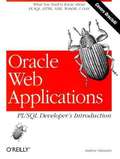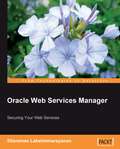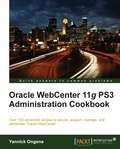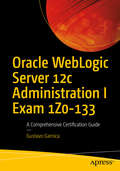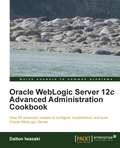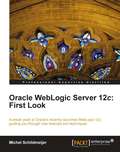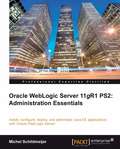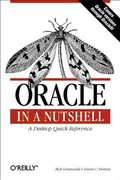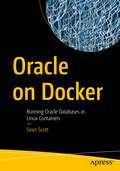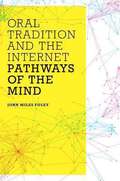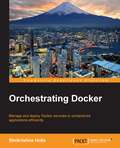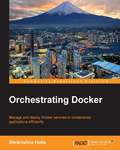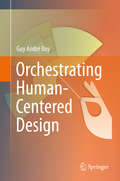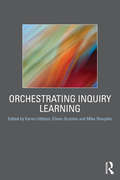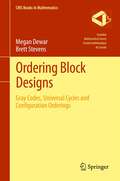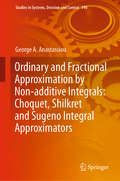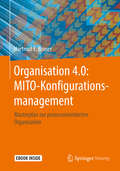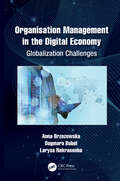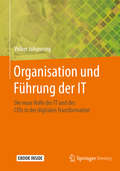- Table View
- List View
Oracle Web Applications: PL/SQL Developer's Introduction
by Andrew OdewahnThis book is an easy-to-understand guide to building Oracle8i (Oracle's "Internet database") Web applications using a variety of tools -- PL/SQL, HTML, XML, WebDB, and Oracle Application Server (OAS). It also covers the packages in the PL/SQL toolkit and demonstrates several fully realized Web applications. This book provides the jump-start you need to extend relational concepts to Web content and to make the transition from traditional programming to the development of useful Web applications for Oracle8i.
Oracle Web Services Manager
by Sitaraman LakshminarayananThis is the book for those who want to learn how to: Secure web services Use Oracle WSM to configure web services security It is mainly for Developers and Architects who want to learn how to use Oracle WSM to address the security challenges of web services and those who want to learn how to use Oracle WSM to address their security needs. If you have a basic knowledge of web services then this book will help you understand the need for security and how to use Oracle WSM to address the security challenges.
Oracle WebCenter 11g PS3 Administration Cookbook
by Yannick OngenaThis is a cookbook filled with numerous recipes for learning important and advanced aspects of administering WebCenter.If you are a WebCenter administrator who wants to keep up to date with the newer version, and learn all the important and advanced aspects of administering WebCenter then this book is for you. You need to have WebCenter installed and to have basic knowledge of administering WebCenter.
Oracle WebLogic Server 12c Administration I Exam 1Z0-133: A Comprehensive Certification Guide
by Gustavo GarnicaUse this comprehensive guide to study for the Oracle WebLogic Server 12c Administration I Exam 1Z0-133. This book is a unique introductory resource to the WebLogic Server certification for new Oracle Fusion Middleware administrators and a valuable resource for veteran WebLogic Server administrators seeking to update their skills for the 12c certification topics. It is common sense that passing a certification exam requires a good command of the subject matter, understanding the intricacies surrounding its practice, and having sufficient experience working with the concepts. This book aims to accelerate the process by providing an accurate review of all exam topics, suggesting hands-on practices to gain or reinforce experience working with WebLogic Server, and introducing questions to help candidates become familiar with the format and style of questions found on the actual certification exam. Oracle WebLogic Server 12c Administration I Exam 1Z0-133 covers the associate level certification with Oracle. Although not dedicated to exam 1Z0-599, the guide is also a valuable foundational resource for those preparing for WebLogic Server 12c implementation specialist level certification. This book: Inspects the certification topics in the order that you would likely follow in an on-the-job middleware infrastructure projectIs a great resource for candidates preparing for the certification, who are unable to start with live or personally-assisted trainingIs a great starting point for those pursuing advanced Oracle WebLogic Server certifications What You’ll Learn Cover all topics on the certification exam 1Z0-133Become familiar with the types and format of questions on the certification examUnderstand and properly describe Oracle WebLogic Server domains and clustersInstall, configure, maintain, and monitor Oracle WebLogic ServerDeploy and manage applications on Oracle WebLogic ServerDiscover how to use new administration features of Oracle WebLogic Server 12c Who This Book Is For Certified Oracle WebLogic administrators seeking to update their Oracle WebLogic Server credentials, as well as experienced WebLogic Server administrators seeking to earn certification for the first time. Non-Oracle administrators seeking to earn a WebLogic Server certification will also find this book useful.
Oracle WebLogic Server 12c Advanced Administration Cookbook
by Dalton IwazakiUsing real life problems and simple solutions this book will make any issue seem small. WebLogic Server books can be a bit dry but Dalton keeps the tone light and ensures no matter how complex the problem you always feel like you have someone right there with you helping you along.This book is ideal for those who know the basics of WebLogic but want to dive deeper and get to grips with more advanced topics. So if you are a datacenter operator, system administrator or even a Java developer this book could be exactly what you are looking for to take you one step further with Oracle WebLogic Server.
Oracle WebLogic Server 12c: First Look
by Michel SchildmeijerThis book is written in simple, easy to understand format with lots of screenshots and step-by-step explanations to get you started with the exciting new features. If you are a WebLogic Server administrator or developer excited about the new features introduced in the 12c version, then this is the guide for you. A Working knowledge of previous WebLogic versions is preferable.
Oracle Weblogic Server 11gR1 PS2: Administration Essentials
by Michel SchildmeijerThis book is written in an easy-to-read style, with a strong emphasis on real-world, practical examples. Step-by-step explanations are provided for performing important administration tasks. If you are a web server administrator looking for a quick guide for performing routine and important WebLogic server administration functions, including configuring WebLogic server and deploying Java EE applications, then this is a perfect book for you. No knowledge of administering WebLogic server is required.
Oracle in a Nutshell
by David C. Kreines Rick GreenwaldThe goal of Oracle in a Nutshell is to pull together the most essential information on Oracle architecture, syntax, and user interfaces. The content and format of this book, an admirable addition to O'Reilly's respected In-a-Nutshell line, combine to boil down vital Oracle commands, language constructs, parameters, and file formats in a succinct and highly accessible desktop reference.
Oracle on Docker: Running Oracle Databases in Linux Containers
by Sean ScottDiscover the benefits of running Oracle databases in Linux containers. This book approaches containers from the perspective of database administrators, developers, and systems administrators. It explains the differences between containers and virtual machines and describes why containers deliver greater speed, flexibility, and portability, with lower resource requirements. You’ll learn how running Oracle databases in containers complements existing database infrastructure and accelerates development, and you’ll understand the advantages they offer for test and validation environments. This book teaches you how to begin working with Oracle databases in Docker, covering the steps for preparing and installing software on Windows, Mac, and Linux systems. It describes the steps for deploying Oracle databases, separating data and configurations from database software, and networking and communicating with your containers. It introduces the Docker commands you’ll use for managing containers, including tips and shortcuts to make everyday tasks easier. Databases have unique demands for performance and reliability, and this book addresses those qualities with discussions on protecting, persisting, and distributing data. Other books may overlook these topics and approach containers as disposable commodities in serverless environments or convenient coding platforms. You’ll gain battle-tested insights for customizing and extending your containers to meet different needs. The opening chapters concentrate on the practical steps of running Oracle databases in Docker. Once you’re comfortable with container terminology and methods, you’ll look deeper at the real power behind containers—preparing and building images, and the templates that form the foundation beneath every container. You’ll begin by modifying publicly available image manifests, or Dockerfiles, following multiple examples that add functionality and capabilities to your databases. You’ll discover methods for using run-time options to create flexible and extensible images that adapt to real-world requirements. Within the pages, you’ll see how Oracle and Docker empower you to confidently build and deploy systems. It’s written with databases and database users in mind and delivers practical advice based on the author’s real-world, battle-tested experiences deploying and running Oracle databases in containers since 2014. With Oracle databases in containers, database administrators have the ideal platform for evaluating performance, practicing database upgrades and migrations, validating backup and recovery processes, and hardening environments. Developers will find that the marriage of Oracle and Docker simplifies code and application tests. Docker’s unique ability to isolate data artifacts improves reliability and confidence in test and QA processes. If you’re a database administrator, this book will help you join the container revolution sweeping the industry and making IT professionals more productive than ever! What You Will LearnRecognize when and why to use containers for an Oracle databaseUnderstand container terminology and architectureCreate and customize Oracle databases in containersBuild and extend images and containers for multiple usesStore and persist data beyond the container ecosystemUse popular database tools with databases in containersExplore container networking and connect multiple container databasesManage, monitor, and secure containersWrite Dockerfiles to support custom requirementsPackage and deploy data artifacts that accelerate development, test, and QA activitiesWho This Book Is ForDatabase administrators, developers, and systems administrators who want to be more productive by running Oracle databases in Linux containers
Oral Tradition and the Internet: Pathways of the Mind
by John Miles FoleyThe major purpose of this book is to illustrate and explain the fundamental similarities and correspondences between humankind's oldest and newest thought-technologies: oral tradition and the Internet. Despite superficial differences, both technologies are radically alike in depending not on static products but rather on continuous processes, not on "What?" but on "How do I get there?" In contrast to the fixed spatial organization of the page and book, the technologies of oral tradition and the Internet mime the way we think by processing along pathways within a network. In both media it's pathways--not things--that matter. To illustrate these ideas, this volume is designed as a "morphing book," a collection of linked nodes that can be read in innumerable different ways. Doing nothing less fundamental than challenging the default medium of the linear book and page and all that they entail, Oral Tradition and the Internet shows readers that there are large, complex, wholly viable, alternative worlds of media-technology out there--if only they are willing to explore, to think outside the usual, culturally constructed categories. This "brick-and-mortar" book exists as an extension of The Pathways Project (http://pathwaysproject.org), an open-access online suite of chapter-nodes, linked websites, and multimedia all dedicated to exploring and demonstrating the dynamic relationship between oral tradition and Internet technology
Orchard CMS: ASP.NET Website Development Made Easy
by John ZablockiUse your C# skills to build your next website with Orchard, the popular content management system based on ASP.NET MVC. With step-by-step guidance, you’ll learn your way around the Orchard environment by constructing a complete, real-world site throughout the course of this book. You’ll create, manage, and display dynamic content with out-of-the-box functionality, and then build themes, modules, and widgets to customize the site.Author John Zablocki gets you started by showing you how to obtain and compile the Orchard source code, so you can more efficiently customize and manage the sites you create.Create or extend Orchard content types to manage dynamic contentUse alternate templates to change the way Orchard displays contentDesign a theme to define your website’s look and feelBuild custom modules when the Orchard Gallery doesn’t have extensions you needCreate reusable content pieces by creating widgetsExplore options for adding multi-language support to a siteLearn hosting options for your Orchard sites, including the cloudPackage your custom themes and modules to share in Orchard Gallery
Orchestrating Docker
by Shrikrishna HollaIf you are a competent developer or DevOps with a good understanding of Linux filesystems but want to manage and orchestrate Docker services, images, and products using a multitude of techniques, then this book is for you. No prior knowledge of Docker or container virtualization is required.
Orchestrating Docker
by Shrikrishna Holla<P><P>About This Book <P><P>Set up your own Heroku-like PaaS by getting accustomed to the Docker ecosystem <P><P>Run your applications on development machines, private servers, or the cloud, with minimal cost of a virtual machine <P><P>A comprehensive guide to the smooth management and development of Docker containers and its services <P><P>Who This Book Is For <P><P>If you are a competent developer or DevOps with a good understanding of Linux filesystems but want to manage and orchestrate Docker services, images, and products using a multitude of techniques, then this book is for you. No prior knowledge of Docker or container virtualization is required. <P><P>What You Will Learn <P><P>Get familiar with the processes related to the automation of Docker <P><P>Get to grips with various Docker commands and techniques that help you manage containers <P><P>Create your own Docker image and package your web application in the image <P><P>Use Dockerfile DSL to make your Docker images repeatable <P><P>Deploy a high availability service on a cluster using CoreOS and fleet <P><P>Build your application in sandboxed Docker containers <P><P>In Detail <P><P>Docker is growing in popularity by day because of its great utility, the fact that it's user friendly, and the vibrant community. <P><P>This book will help you transform the way you build, test, and deploy your applications with Docker, making it easier and enjoyable. The book starts off with the installation of Docker before gradually taking you through the different commands to start working with Docker containers and their services. You will learn to build your own Docker containers along with instructions to fine-tune the resource allocations to those containers. You will then learn to manage a cluster of Docker containers. The book demonstrates the processes related to the automation and orchestration of Docker. It then covers the compatibility of Docker with other technologies such as Puppet and Chef. Finally, it prepares you to ship your applications without taking strain for deployment. By the end of the book, you will be able to orchestrate and manage the creation and deployment of Docker containers.
Orchestrating Human-Centered Design
by Guy BoyThe time has come to move into a more humanistic approach of technology and to understand where our world is moving to in the early twenty-first century. The design and development of our future products needs to be orchestrated, whether they be conceptual, technical or organizational. Orchestrating Human-Centered Design presents an Orchestra model that attempts to articulate technology, organizations and people. Human-centered design (HCD) should not be limited to local/short-term/linear engineering, but actively focus on global/long-term/non-linear design, and constantly identify emergent properties from the use of artifacts. Orchestrating Human-Centered Design results from incremental syntheses of courses the author has given at the Florida Institute of Technology in the HCD PhD program. It is focused on technological and philosophical concepts that high-level managers, technicians and all those interested in the design of artifacts should consider. Our growing software -intensive world imposes better knowledge on cognitive engineering, life-critical systems, complexity analysis, organizational design and management, modeling and simulation, and advanced interaction media, and this well-constructed and informative book provides a road map for this.
Orchestrating Inquiry Learning
by Mike Sharples Karen Littleton Eileen ScanlonThere is currently a rapidly growing interest in inquiry learning and an emerging consensus among researchers that, particularly when supported by technology, it can be a significant vehicle for developing higher order thinking skills. Inquiry learning methods also offer learners meaningful and productive approaches to the development of their knowledge of the world, yet such methods can present significant challenges for teachers and students. Orchestrating Inquiry Learning addresses the key challenge of how to resource and support processes of inquiry learning within and beyond the classroom. It argues that technological support, when coupled with appropriate design of activities and management of the learning environment, can enable inquiry learning experiences that are engaging, authentic and personally relevant. This edited collection of carefully integrated chapters brings together, for the first time; work on inquiry learning and orchestration of learning. Drawing upon a broad range of theoretical perspectives, this book examines: Orchestration of inquiry learning and instruction Trajectories of inquiry learning Designing for inquiry learning Scripting personal inquiry Collaborative and collective inquiry learning Assessment of inquiry learning Inquiry learning in formal and semi-formal educational contexts Orchestrating Inquiry Learning is essential reading for all those concerned with understanding and promoting effective inquiry learning. The book is aimed at an international audience of researchers, post-graduate students, and advanced undergraduates in education, educational technology and psychology. It will also be of interest to educational practitioners and policy makers, including teachers, educational advisors, teacher-students and their trainers.
Order in Chaos - Cybernetics of Brand Management (essentials)
by Oliver Errichiello Marius WernkeCybernetics is a science for understanding and systematically using information. As a subject of cybernetics, the brand is becoming increasingly important, especially in times of acceleration and infinite, global commodity markets. Only those who are able to preserve their patterns in the age of change and adapt them again and again to the requirements of the times will survive. Neither customer data nor creative ideas help here, but a sound knowledge of the structural functioning of all living beings - organic and social. By bringing together brand sociology and management cybernetics, this essential clarifies the invisible social forces of attraction. By illustrating the overarching dynamics of all (living) systems, universal insights can be gained and planned strategies developed.
Ordering Block Designs
by Megan Dewar Brett StevensThe study of combinatorial block designs is a vibrant area of combinatorial mathematics with connections to finite geometries, graph theory, coding theory and statistics. The practice of ordering combinatorial objects can trace its roots to bell ringing which originated in 17th century England, but only emerged as a significant modern research area with the work of F. Gray and N. de Bruijn. These two fascinating areas of mathematics are brought together for the first time in this book. It presents new terminology and concepts which unify existing and recent results from a wide variety of sources. In order to provide a complete introduction and survey, the book begins with background material on combinatorial block designs and combinatorial orderings, including Gray codes -- the most common and well-studied combinatorial ordering concept -- and universal cycles. The central chapter discusses how ordering concepts can be applied to block designs, with definitions from existing (configuration orderings) and new (Gray codes and universal cycles for designs) research. Two chapters are devoted to a survey of results in the field, including illustrative proofs and examples. The book concludes with a discussion of connections to a broad range of applications in computer science, engineering and statistics. This book will appeal to both graduate students and researchers. Each chapter contains worked examples and proofs, complete reference lists, exercises and a list of conjectures and open problems. Practitioners will also find the book appealing for its accessible, self-contained introduction to the mathematics behind the applications.
Ordinary and Fractional Approximation by Non-additive Integrals: Choquet, Shilkret and Sugeno Integral Approximators (Studies in Systems, Decision and Control #190)
by George A. AnastassiouOrdinary and fractional approximations by non-additive integrals, especially by integral approximators of Choquet, Silkret and Sugeno types, are a new trend in approximation theory. These integrals are only subadditive and only the first two are positive linear, and they produce very fast and flexible approximations based on limited data. The author presents both the univariate and multivariate cases. The involved set functions are much weaker forms of the Lebesgue measure and they were conceived to fulfill the needs of economic theory and other applied sciences. The approaches presented here are original, and all chapters are self-contained and can be read independently. Moreover, the book’s findings are sure to find application in many areas of pure and applied mathematics, especially in approximation theory, numerical analysis and mathematical economics (both ordinary and fractional). Accordingly, it offers a unique resource for researchers, graduate students, and for coursework in the above-mentioned fields, and belongs in all science and engineering libraries.
Ordnung im Chaos – Kybernetik der Markenführung (essentials)
by Oliver Errichiello Marius WernkeDie Kybernetik ist eine Wissenschaft, um Informationen zu verstehen und systematisch zu nutzen. Als Thema der Kybernetik wird die Marke gerade in Zeiten der Beschleunigung und der unendlichen, globalen Warenmärkte zunehmend wichtiger. Denn Bestand hat nur, wer vermag, sein Muster im Zeitalter der Veränderung zu bewahren und immer wieder an die Erfordernisse der Zeit anzupassen. Dabei helfen weder Kundendaten noch kreative Ideen, sondern eine fundierte Kenntnis der strukturellen Funktionsweise aller Lebewesen – organischer und sozialer. Durch die Zusammenführung von Markensoziologie und Management-Kybernetik werden in diesem essential die unsichtbaren sozialen Anziehungskräfte verdeutlicht. Indem die übergreifenden Dynamiken aller (lebenden) Systeme dargestellt werden, lassen sich universelle Erkenntnisse gewinnen und planvolle Strategien entwickeln.
Org Design for Design Orgs: Building and Managing In-House Design Teams
by Peter Merholz Kristin SkinnerDesign has become the key link between users and today’s complex and rapidly evolving digital experiences, and designers are starting to be included in strategic conversations about the products and services that enterprises ultimately deliver. This has led to companies building in-house digital/experience design teams at unprecedented rates, but many of them don’t understand how to get the most out of their investment. This practical guide provides guidelines for creating and leading design teams within your organization, and explores ways to use design as part of broader strategic planning.You’ll discover:Why design’s role has evolved in the digital ageHow to infuse design into every product and service experienceThe 12 qualities of effective design organizationsHow to structure your design team through a Centralized PartnershipDesign team roles and evolutionThe process of recruiting and hiring designersHow to manage your design team and promote professional growth
Organic Social Media: How to Build Flourishing Online Communities
by Jenny Li FowlerOrganizations and institutions focused on community building have a built-in group of ambassadors who embrace their message and vision. Social media managers have a unique opportunity to lean into this loyalty by creating a social presence informed by this digital engagement. In Organic Social Media, Jenny Li Fowler outlines the important steps that social media managers need to take to enhance an organization's broader growth objectives. Fowler breaks down the important questions to help readers determine the best platforms to invest in, how they can streamline the approval process and other essential strategic steps to create an organic following on social platforms.Organic Social Media explains how to elevate the key growth objectives of a brand by creating or recreating its online presence. Early chapters walk readers through the planning phase, the process of strategic goal setting, platform selection, resource management and content discovery. Later chapters focus on executing these established plans and offer a strategic way to build a content calendar and track the success of social. With this book, social media managers will future-proof the online presence of any organization.
Organisation 4.0: Masterplan zur prozessorientierten Organisation
by Hartmut F. BinnerWie Unternehmen die Herausforderungen, mit denen sie konfrontiert sind, erfolgreich managen können, beschreiben unzählige Ratgeber.Dieses Buch stellt im Detail den Weg dorthin, das „Wie“, in den Vordergrund. Der Autor verfolgt dabei einen ganzheitlichen, prozessorientierten Ansatz der Organisationsentwicklung.In dem Buch wird der Weg von einer funktionsorientierten hin zu einer prozessorientierten Organisation detailliert und anhand von vielen Anwendungsbeispielen beschrieben. Der Autor stellt Modelle, Methoden, Vorgehensweisen und Tools für die Umsetzung vor. Das MITO-Modell mit seinem Methoden-Tool als generischem Methodenbaukasten wird umfassend erläutert. Bezugspunkt für das Changemanagement ist dabei nicht die vertikale, also hierarchische Organisationsstruktur, sondern, ausgehend von einer rollenbasierten Ordnungsstruktur, die horizontale Wertschöpfungskette. Erst aus dieser detaillierten rollenbasierten Beschreibung des End-to-End-Businessprozesseses ergeben sich die Prozessaufgaben und Prozessverantwortlichkeiten. Dies wiederum ermöglicht eine hohe Datendurchgängigkeit für die Prozessdigitalisierung mit neuen Technologien wie Cloud Computing, Enterprise Mobility, Social Business, Big Data in der Organisation 4.0.In dem Buch werden alle Fragen rund um das gemeinsame Führungsverständnis in einer prozessorientierten Organisation besprochen. Auch der Aufbau einer gemeinsamen Wissens- und Lernplattform zur Qualifizierung von Führungskräften und Mitarbeitern wird behandelt. Wie lassen sich Prozesse systematisch beschreiben und im Rahmen eines ganzheitlichen Business Process Management (BPM) umsetzen? Wie können funktionsorientierte Veränderungs-, Anforderungs- und Auswirkungsanalysen durch prozessorientierte Analysen ersetzt werden? Wie lässt sich eine prozessorientierte Organisation evaluieren? Das Buch analysiert diese und weitere Fragen systematisch und detailliert und vermittelt Führungskräften nicht nur das notwendige Wissen, sondern auch die Methodenkompetenz, um Changemanagement-Prozesse umzusetzen.Ob Mittelstand oder Großunternehmen – das Buch richtet sich an alle Führungskräfte in Unternehmen, die sich mit Changemanagement auseinandersetzen.
Organisation Management in the Digital Economy: Globalization Challenges
by Anna Brzozowska Dagmara Bubel Larysa NekrasenkoThis book highlights the essence of information technology in the modern digital world in relation to improvements and threats to organisations and e-business in the era of the digital economy. Rapid IT development has created modern business proposals such as digital and virtual currencies, crowdfunding, peer-to-peer lending, mobile banking, online investing and new payment systems. This allows organisations and firms to increase competitiveness by using financial products and services, thus increasing their value. Information technology users receive significant timesaving and a choice of investment options. At the same time, there is a new challenge for regulators who must monitor how this or that technology affects the financial sector. The authors have collected and systematised information on the models of using information technology in e-business as well as issues of applying information technology in smart organisations and public institutions. The book addresses the issues of risk management in organizations and the problems of personal and social risks resulting from the use of information technology. In addition, the book presents a review of e-commerce sectors and models as well as e-commerce tools, international payment systems and modern money systems. Risks, threats and security rules for using banking services, e-commerce and payment systems are reviewed and systematised.
Organisation und Führung der IT: Die neue Rolle der IT und des CIOs in der digitalen Transformation
by Volker JohanningDas Buch zeigt praxisnah wie sich IT-Organisationen optimal aufstellen müssen in dieser sich dynamisch wandelnden Welt und was dies für die Führung dieser immer wichtiger werdenden IT bedeutet. Darüber hinaus wird das Thema Führung einer IT-Organisation näher beleuchtet: Was ist die Rolle und was sind die Führungsaufgaben eines CIOs? Wie und mit welchen Mitteln kann eine IT-Organisation am besten gesteuert werden? Wie können komplexe Veränderungsprozesse und Transformationen geführt werden? Somit bietet das Buch eine praxisorientierte Anleitung für die Organisationsänderung oder Reorganisation der IT mit vielen Tipps zu Change-Management, Führung sowie agilen Methoden und Ansätzen in der neuen IT-Organisation.
Organisation und Führung in turbulenten Zeiten: Entwurf und Implementierung unter Verwendung des 3-P-Modells
by Peter Wollmann Frank Kühn Michael Kempf Reto PüringerDieses Buch knüpft an die erfolgreiche Entwicklung des Drei-Säulen-Modells (3-P-Modell) der Autoren für die Organisation und Führung in disruptiven Zeiten an. Der Schwerpunkt liegt darauf, dem Leser bei der Umsetzung des Modells zu helfen und eine Vielzahl von Anwendungsfällen für diese VUCA-Zeiten (Volatilität, Ungewissheit, Komplexität und Mehrdeutigkeit), einschließlich globaler Krisen wie der COVID-19-Pandemie, zu liefern. Das Buch deckt ein breites Spektrum von Organisationen ab: privater und öffentlicher Sektor, Nichtregierungsorganisationen, lokale und globale Regierungsinstitutionen, globale Organisationen wie die UNO usw. Darüber hinaus wird aufgezeigt, wie das 3-P-Modell auf Herausforderungen bei der Organisationsgestaltung, dem Management und der Führung angewendet werden kann.
